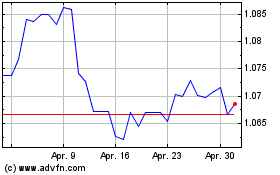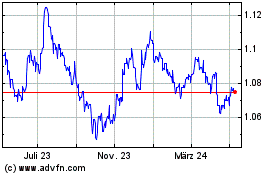Euro Falls As German GDP Slumps To Record Low
30 Juli 2020 - 9:02AM
RTTF2
The euro lost ground against its major opponents in the European
session on Thursday, after a data showed that German economy
contracted to a record low in the second quarter due to coronavirus
restrictions to contain outbreak.
Data from Destatis showed that gross domestic product fell 10.1
percent sequentially after shrinking 2 percent in the first
quarter. This was the largest decline since the records began in
1970. Economists had forecast a decrease of 9 percent.
There was a massive slump in exports and imports of goods and
services as well as for household final consumption expenditure and
capital formation in machinery and equipment.
Meanwhile, data from Federal Employment Agency showed that
German unemployment decreased by 18,000 in July, confounding
expectations for an increase of 43,000.
The jobless rate remained at 6.4 percent versus the expected
rate of 6.5 percent.
A slew of weak earnings updates and ongoing stalemate between
the White House and Congress over new stimulus measures dragged
down European shares.
The euro edged down to 0.9036 against the pound, after rising to
0.9079 at 2:45 am ET. The euro may face support around the 0.88
region, if it weakens again.
The European currency depreciated to a 3-day low of 1.0734
against the franc, from a high of 1.0761 seen at 5:00 pm ET. The
euro is seen challenging support around the 1.06 mark.
Reversing from an early high of 1.1793 against the greenback and
a 2-day high of 123.86 against the yen, the euro fell to 1.1731 and
123.34, respectively. Next near term support for the euro is seen
around 1.12 against the greenback and 119.5 against the yen.
In contrast, the euro rose to near a 2-month high of 1.7756
against the kiwi, 3-day highs of 1.5769 against the loonie and
1.6484 against the aussie, from yesterday's closing values of
1.7678, 1.5724 and 1.6404, respectively. The euro is poised to find
resistance around 1.80 against the kiwi, 1.60 against the loonie
and 1.66 against the aussie.
Looking ahead, at 8:00 am ET, German flash consumer inflation
for July is due.
U.S. GDP data for the second quarter and weekly jobless claims
for the week ended July 25 will be featured in the New York
session.
Euro vs US Dollar (FX:EURUSD)
Forex Chart
Von Mär 2024 bis Apr 2024

Euro vs US Dollar (FX:EURUSD)
Forex Chart
Von Apr 2023 bis Apr 2024
